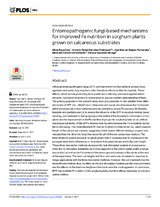Mostrar el registro sencillo del ítem
Entomopathogenic fungi-based mechanisms for improved Fe nutrition in sorghum plants grown on calcareous substrates
| dc.contributor.author | Raya Díaz, Silvia | |
| dc.contributor.author | Sánchez-Rodríguez, Antonio Rafael | |
| dc.contributor.author | Segura-Fernández, José Manuel | |
| dc.contributor.author | Campillo, María del Carmen del | |
| dc.contributor.author | Quesada-Moraga, Enrique | |
| dc.date.accessioned | 2024-02-01T07:53:18Z | |
| dc.date.available | 2024-02-01T07:53:18Z | |
| dc.date.issued | 2017 | |
| dc.identifier.issn | 1932-6203 | |
| dc.identifier.uri | http://hdl.handle.net/10396/26922 | |
| dc.description.abstract | Although entomopathogenic fungi (EPF) are best known for their ability to protect crops against insect pests, they may have other beneficial effects on their host plants. These effects, which include promoting plant growth and conferring resistance against abiotic stresses, have been examined in recent years to acquire a better understanding of them. The primary purposes of the present study were (i) to ascertain in vitro whether three different strains of EPF (viz., Metarhizium, Beauveria and Isaria) would increase the Fe bioavailability in calcareous or non-calcareous media containing various Fe sources (ferrihydrite, hematite and goethite) and (ii) to assess the influence of the EPF inoculation method (seed dressing, soil treatment or leaf spraying) on the extent of the endophytic colonization of sorghum and the improvement in the Fe nutrition of pot-grown sorghum plants on an artificial calcareous substrate. All the EPFs studied were found to increase the Fe availability during the in vitro assay. The most efficient EPF was M. brunneum EAMa 01/58–Su, which lowered the pH of the calcareous medium, suggesting that it used a different strategy (organic acid release) than the other two fungi that raised the pH of the non-calcareous medium. The three methods used to inoculate sorghum plants with B. bassiana and M. brunneum in the pot experiment led to differences in re-isolation from plant tissues and in the plant height. These three inoculation methods increased the leaf chlorophyll content of young leaves when the Fe deficiency symptoms were most apparent in the control plants (without fungal inoculation) as well as the Fe content of the above-ground biomass in the plants at the end of the experiment. The total root lengths and fine roots were also increased in response to fungal applications with the three inoculation methods. However, the soil treatment was the most efficient method; thus, its effect on the leaf chlorophyll content was the most persistent, and the effects on the total root length and fine roots were the most apparent. In conclusion, EPF improved the Fe nutrition of the sorghum plants, but their effects depended on the inoculation method. | es_ES |
| dc.format.mimetype | application/pdf | es_ES |
| dc.language.iso | spa | es_ES |
| dc.publisher | Public Library Of Science (PLOS) | es_ES |
| dc.rights | https://creativecommons.org/licenses/by/4.0/ | es_ES |
| dc.source | Raya-Díaz, S., Sánchez-Rodríguez, A. R., Segura-Fernández, J. M., Del Campillo, M. C., & Quesada‐Moraga, E. (2017). Entomopathogenic fungi-based mechanisms for improved FE nutrition in sorghum plants grown on calcareous substrates. PLOS ONE, 12(10), e0185903. https://doi.org/10.1371/journal.pone.0185903 | es_ES |
| dc.subject | Entomopathogenic fungus | es_ES |
| dc.subject | Biological control | es_ES |
| dc.subject | Plant growth promotion | es_ES |
| dc.subject | Root development | es_ES |
| dc.subject | Fe nutrition | es_ES |
| dc.title | Entomopathogenic fungi-based mechanisms for improved Fe nutrition in sorghum plants grown on calcareous substrates | es_ES |
| dc.type | info:eu-repo/semantics/article | es_ES |
| dc.relation.publisherversion | https://doi.org/10.1371/journal.pone.0185903 | es_ES |
| dc.relation.projectID | Junta de Andalucía. AGR-7681 | es_ES |
| dc.rights.accessRights | info:eu-repo/semantics/openAccess | es_ES |

